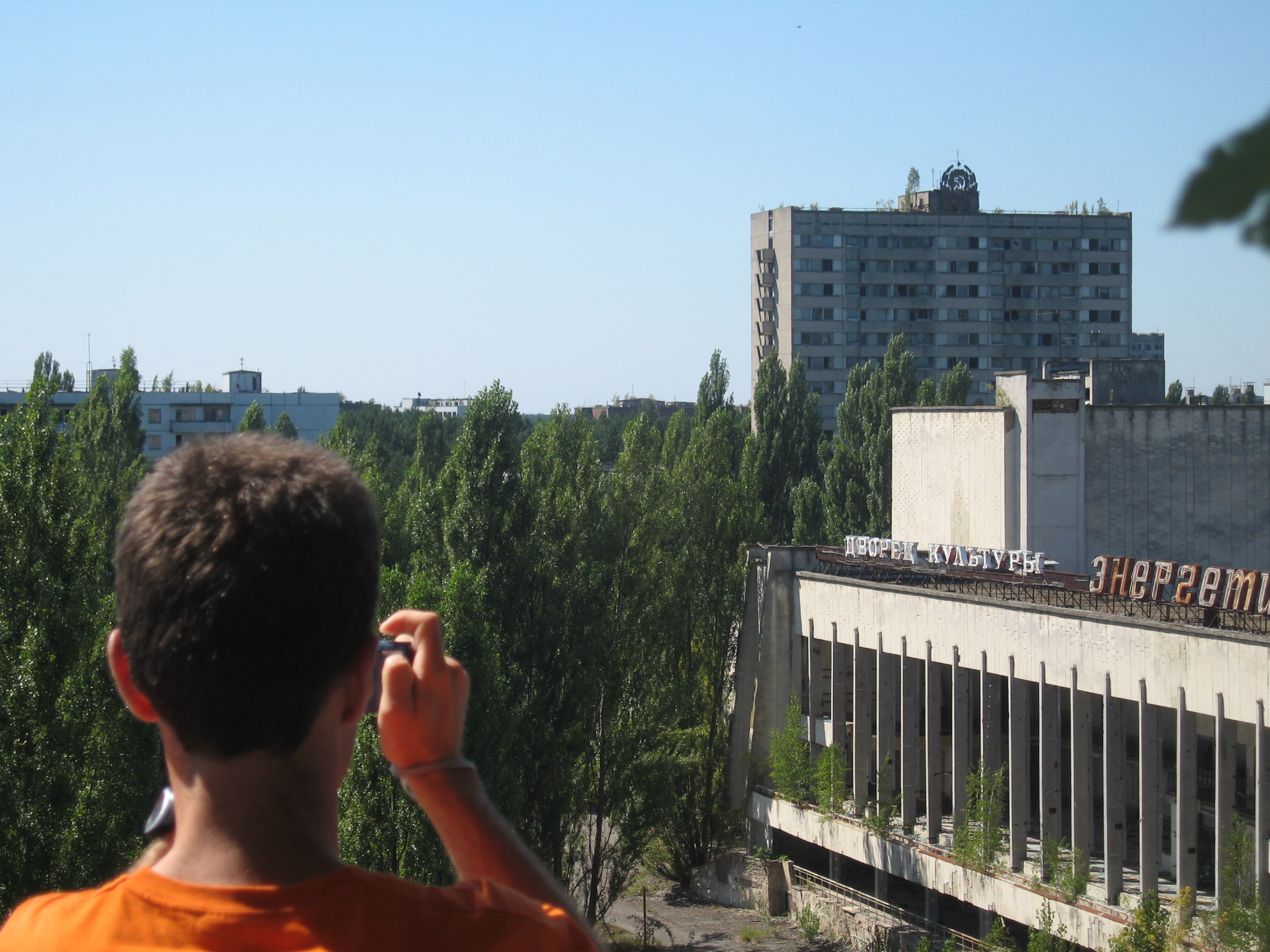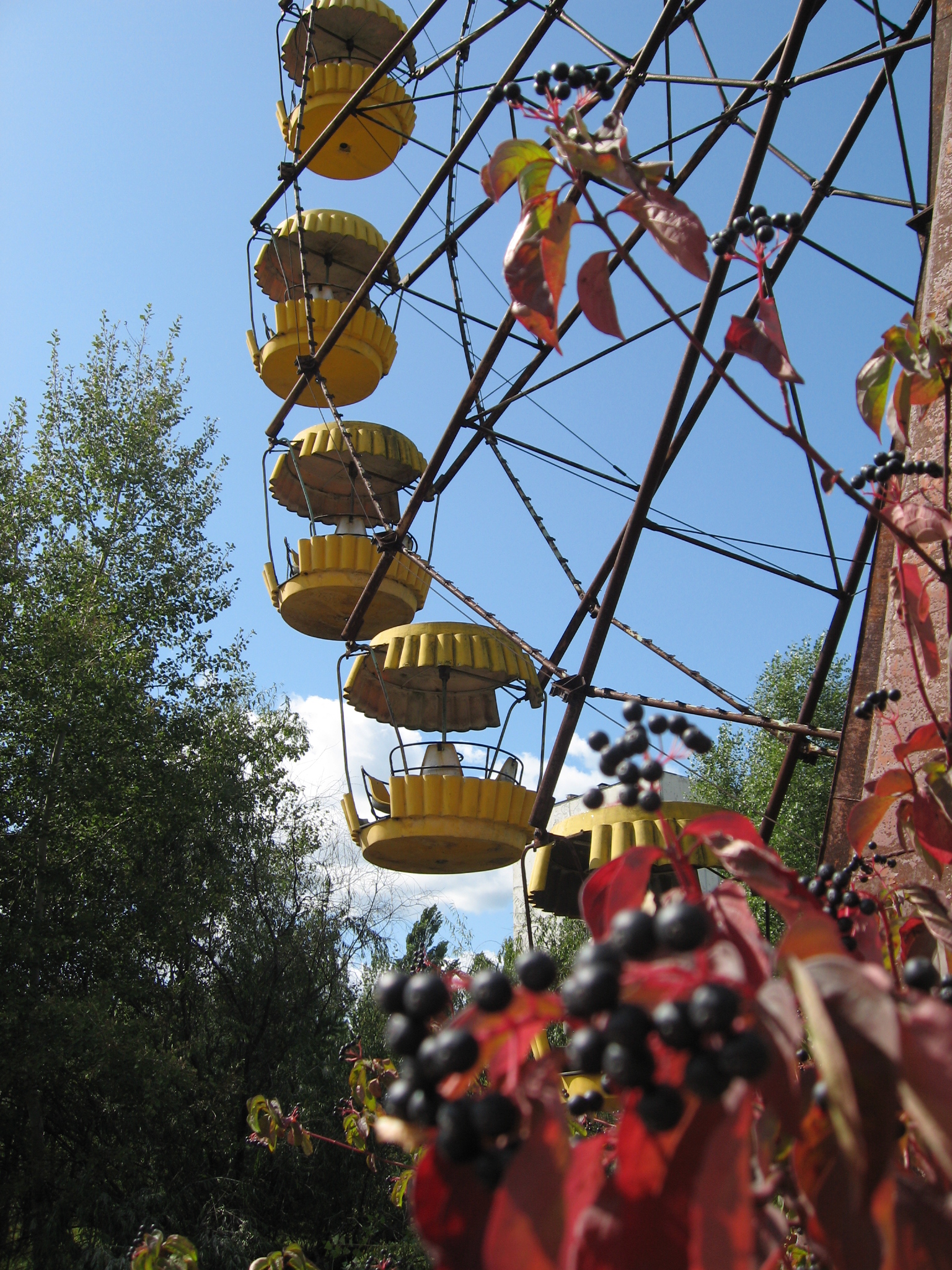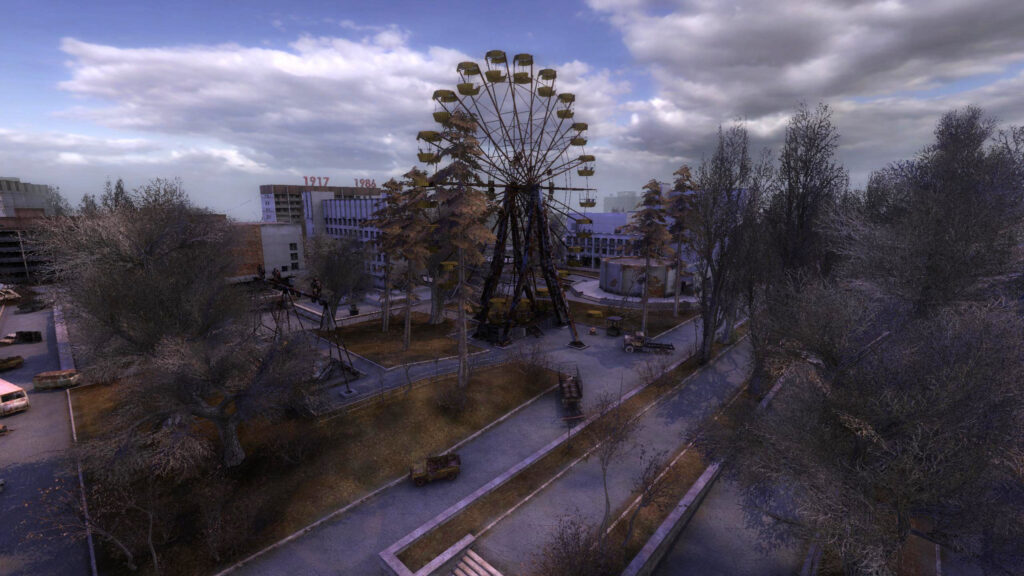Dr Nick Rush-Cooper, Teaching Fellow in the Department of Geography, University of Durham, UK.
We are in pitch darkness. Maxim, the lead tour guide, leads the group of visitors from the front and takes us down a short corridor within the ruins of ‘Energetik’; the cultural centre of Pripyat, the town built to house the workers of the Chernobyl Nuclear Power Plant. I’m taking up the rear and a visitor turns to ask me where this leads. “To the back of the centre where we exit to reach where the Ferris wheel is” I tell them, though, in all honestly, that’s partly a guess and I’m not really sure. I may have visited the Zone almost a dozen times for the purposes of my PhD, and will visit over a dozen more, but this is only the second day I’m working as a tour guide[1] and I think that Maxim’s having some fun with me by taking the group through paths I’ve not used before. But it’s a short corridor and, soon enough, we emerge into the sunlight streaming into the small swimming pool at the back of the centre.
We pause as visitors begin to take photographs, and I continue a conversation from earlier with a visitor; she explains to me that despite the bright sunlight and the sheer amount of greenery, she finds the place unsettling; “like a horror movie.” Another visitor chimes in; “or something like I Am Legend.” The first exclaims; “I’m amazed at how green it is; I’ve been playing a lot of Fallout 3, so I was expecting more of a wasteland.” As we speak a member of the group has jumped into the swimming pool to have a closer look at the old film reels that have been dumped there.

He picks a section up to show that it contains images of Tower Bridge. “Something about the evil capitalist British!” he jokes.
In recent years the Chernobyl Zone has had some interesting cultural influences on popular media. The landscape of the Zone is clearly a key reference point for the abandoned aesthetic key to the recent wave of popular post-apocalyptic narratives and visitors would often compare the Zone to scenes from films such I am Legend (2007) and The Road (2009) and games such as the renewed Fallout series (2008 & 2010). In later years the Chernobyl reference point would become explicit in the use of Pripyat as setting in films such as Transformers: Dark of the Moon (2011) and A Good Day to Die Hard (2013) and in the Call of Duty game franchise. On the one hand this is easily dismissed as a kind of currency of authenticity surrounding the abandonment aesthetic, on the other it seems tacit acknowledgement that contemporary popular media in the post-apocalyptic or dystopian genre struggles to conjure catastrophes as conclusive as those of the 20th Century (Berger 1999). But there’s a more interesting cinematic lineage of Chernobyl than Hollywood’s inability to synthesise the material conditions of the Zone as anything more than an aesthetic; one which speaks to the uniquely uncanny, material and embodied aspects of its landscape.
…nothing about the Chernobyl Zone is ever straightforward.
However, nothing about the Chernobyl Zone is ever straightforward. So in charting this particular relationship of the Chernobyl Zone with film and beyond we have to eschew a simple chronology, for our journey starts before the disaster of 1986, with Stalker, the 1979 film by Andrei Tarkovsky. On the film the titular Stalker guides two others into a controlled zone of ambiguous yet ever-present danger where they hope to find ‘the room’ rumoured to grant the wish of anyone who enters. Militarily controlled and replete with invisible dangers, it’s no surprise that the film has been considered oddly premonitory of the Chernobyl Exclusion Zone. Such invisible dangers were not entirely fictitious, as the landscape for the filming, in an industrial area near Tallinn, Estonia, has been blamed by those who worked on the film as being responsible for illness amongst the crew. The similarities can be found in the directorship of the film; my daily trip from the post-war Soviet architecture of central Kyiv to the city-in-a-forest that is now Pripyat mirrored the film as it shifts from a grey/brown monochrome to an increasingly vivid palette as the protagonists enter the Zone (Tarkvovsky was known to paint leaves green in his movies for added effect). Stalker is constructed of many lingering shots, much of them of careful, slow and silent movement through the industrial ruins. The ruined landscape itself becomes known through these movements as a threatening presence; the invisible dangers are not shown but rather made present through the careful, attentive and tentative movement of the Stalker and his companions. Moments echoed in the footsteps of visitors as they carefully make their way over collapsing floors, strewn debris and the silence borne of their concentration only punctuated by the chirruping of the guide’s Geiger counter.
…strewn debris and the silence borne of their concentration only punctuated by the chirruping of the guide’s Geiger counter.
In mid-2002, Kyiv based game development team GSC Game World, previously known for a series of historical strategy games, were struggling to find direction for their prototype action game Oblivion Lost. A linear game with robots, teleportation and guns that did not seem to be developing into anything interesting, GSC opted for a complete re-write of the fictional basis for the game. In documents released with the game, the designers explain that:
“Firstly, here in the Ukraine, we are surrounded by splinters of the Soviet Empire – forgotten production facilities, catacombs and neglected military establishments and so on. Even our company office located at a disused Soviet factory, is a perfect example. Living your life day to day in such areas can’t leave you untouched or unmoved.”
Along with the secrecy of the Soviet era wherein “even the most harmless incidents became a catalyst for the organic evolution of rumour and legend” (with the rumours of psychological warfare at the heart of the woodpecker antennas being most emblematic of this secrecy and rumour within the Zone) the team moved the setting of the games to the Chernobyl Zone. At the same time the game was given the S.T.A.L.K.E.R. with the release of S.T.A.L.K.E.R.: Shadow of Chernobyl in 2007, followed by S.T.A.L.K.E.R.: Clear Sky in 2008 and S.T.A.L.K.E.R.: Call of Pripyat in 2010[2]. This naming points to the second key influence alongside the Chernobyl Zone, to both Stalker and the novel Roadside Picnic by the Strugatsky brothers (who adapted the novel into the screenplay for Stalker). The developers’ own experiences with the ‘splinters’ of empire, the legacy of both secrecy and global awareness of Chernobyl become linked with the premonitory nature of Stalker. It spoke as well for a desire that Chernobyl not be forgotten, noting that “as time passes, people start forgetting about the accident and the related problems which Ukraine has to cope with, now virtually independently.”[3]
As guides to the Zone one of our primary roles is, unsurprisingly, safety; aiding in the navigation of dangers from radiation to rotting floorboards. When not carefully directing visitors through the debris strewn, collapsing and radioactive ruins we might find time to talk to them about the events of 1986 and their aftermath. But this is no guided tour, there is no script that guides read from. This lack of script was a conscious decision; as another guide, Yuri, told me the aim was to allow visitors to develop their own emotional responses, to make sense of the Zone and its history on their own terms. As a visitor noted, the Zone is not “as sanitised as Auschwitz is.” Visitation to the Zone (in comparison to many tourist destinations) is much more lively, imaginative and productive than scripted, determined and managed. Another visitor noted that, despite the pace of decay, that they were “really trying to get a sense of what life was like, and I felt like I got some of that. A lot of it actually … swimming pools and schools, it’s kinda like everywhere else.” Similar sentiments were expressed by many international visitors, familiar with old anti-USSR rhetoric, as they found themselves attempting to excavate a sense of life ‘behind the curtain’.

Back in the Chernobyl Zone, on a later trip, and we’re in the basement of what was once a building used as a Synagogue near the town of Chernobyl, south of the power plant. (The town itself still hosts those who are employed in the ongoing monitoring and maintenance of the Zone, as well as the construction of the ‘New Safe Confinement’ that will replace the iconic ‘sarcophagus’ over Reactor 4.) Making our way through the basement, we again find ourselves in a darkened corridor. Here the floor has rotted in many places, the floor covering sagging where floorboards have fallen away, only the joists provide stable footing. As we carefully place one foot in front of another the cameras come out, flashes start to go off and the corridor fills with an odd strobing effect as the tourists’ equipment becomes re-purposed as a tool for navigating this ruin.
Guiding and touring the landscape of the Zone is something more than a visual experience, more than a means to replicate photographs that carry the abandoned and ruined aesthetic with which it has become synonymous. Visitors gain a heightened sense of and attention to their movements within this space. As primarily spatial medium, games are interesting in the manner they relate to real landscapes, as they do so through more-than-visual means. As I have recounted elsewhere, visitors who had previously played games set in the Zone had sense in which they were travelling to place that they had not only seen before, but which they knew in an embodied, spatial manner. The S.T.A.L.K.E.R. games were key to this, for in setting the games in the Chernobyl Zone the result was more than to borrow the visual cues of the ‘splinters of Soviet Empire’, it ended up shaping core aspects of the game.
Guiding and touring the landscape of the Zone is something more than a visual experience, more than a means to replicate photographs…
Just as Stalker is a re-formulation of Roadside Picnic as a parable (after Arkady Strugatsky consciously dropped the sci-fi elements) the S.T.A.L.K.E.R. games eschew a re-telling of the narratives of either the novel or the film and instead they serve to draw and build upon a shared stalker mythos. The result of this influence was to drop the linear action-adventure game in favour of a more open approach; the player free to explore. (At least for the first half of the game before it descends into awkwardly told science fiction of Soviet experiments on consciousness). At the heart of this is the much touted “ALife” artificial intelligence system wherein all characters’ actions are driven by a set of desires (often to reach the games’ version of the ‘wish granter’; a 2001-esque obelisk within Reactor 4) and rivalries that are used to generate the narrative flow of exploration.
Within this mythos we find recurrent themes of invisible dangers, supernatural ‘anomalies’, military control, secrecy and men drawn to the Zone for intrigue and exploitation. S.T.A.L.K.E.R. borrows much from Roadside Picnic with regards to the science fiction elements, whilst – despite the presence of guns and direct conflict – the games maintain a close fidelity to the careful, considered and cautious navigation of the Zone in Stalker. Though often poorly written, fatally clichéd in places and riddled with ‘bugs’ the games are highly regarded for their ‘atmosphere’; for the tension, sense of place and uncanny nature of the games’ Zone that, importantly, are expressed through the manner in which the player encounters the Zone rather than through narrative exposition.
Although the environmental game engine of Oblivion Lost lent itself to being re-purposed for the Zone with its rusted, overgrown ruins where vegetation disrupts the neat geometries of crumbling Soviet architecture, in hand with the Stalker mythos, the setting of the Zone became much more than aesthetic. It is not simply down to the visual re-creation of parts of the Chernobyl Zone but is core to the manner in which the setting of the Zone shaped the game’s design process. In the ‘borrowing’ of the architecture of the Zone, GSC carry across its meaning, imbuing their games with the specifics of this unique landscape. In the S.T.A.L.K.E.R. the dual dangers of radiation and anomalies are used to render the landscape as the primary antagonist of the series. Players spend much of their time enacting the same careful, tentative exploration of the Zone’s ruined, radioactive landscape as we see in Stalker. Where in Call of Duty the radiation of the Zone simply becomes a tool for designers to funnel the player down a specific route, the S.T.A.L.K.E.R. utilise the careful navigation of the radioactive, ruined landscape to mimic the manner in which Stalker imbues landscape with threat through careful, embodied navigation.

As in Roadside Picnic, players can throw small items into these anomalies, carefully teasing out the size, shape and extent of their influence. Meanwhile the crackle of the Geiger counter remains a constant companion, as anomalies and radiation render open spaces into twisting mazes. The landscape of the Zone in S.T.A.L.K.E.R. is not a puzzle, laid out for the player to solve; along with the “ALife” system it serves as a space that exists despite of and beyond the player’s machinations; the player in the S.T.A.L.K.E.R. finds themselves in a position that is very different from the usual exceptionalism of American blockbuster fare; the player is not the centre of the game, the player is just there.
…the crackle of the Geiger counter remains a constant companion, as anomalies and radiation render open spaces into twisting mazes.
It’s a warm sunny day late in the summer and I’m in the later stages of my research. I’ve been left alone in the small park in Pripyat in which stands the iconic, rusting Ferris wheel. I swear I can hear it creak occasionally. I’m here to gather a few readings for an experimental mapping project, attempting to record the manner in which radiation levels can shift by large factors over short distances throughout Pripyat.

Geiger counter in my hand, watching it’s LED display, I walk up and down, stopping to record measurement at regular intervals. I find myself feeling uneasy, and I initially cannot place it; at worst I’m going to have an awkward conversation with a member of the Zone’s police about what I’m doing here. After a while I place this sense of unease; I’ve done this before: Carefully, tentatively and with both trepidation and purpose, I’m being reminded of S.T.A.L.K.E.R., my Geiger counter reminiscent of the game’s ‘anomaly detector’ in my out stretched hand. I realised, then, that the games, in their dual inspiration in the Stalker mythos and Chernobyl, they had found a way to evoke some of the qualities – between threat and intrigue, between familiar and alien – of the unique landscape of the Chernobyl Exclusion Zone.
Dr Nick Rush-Cooper is interested in landscape, subjectivity and the role of non-human agencies in knowledge production. He completed his PhD at the University of Durham titled ‘Exposures: Exploring Selves and Landscapes in the Chernobyl Exclusion Zone’. His current research considers the relationship between computer and video game spaces and the ‘real’ spaces upon which they are based. You can follow him on twitter here.
[1] This was an arrangement of mutual convenience with the tour operator who arranged access for the purposes of my research: I would attend and assist as a tour guide for the tour operator alongside the government employed tour guide in return for a waived entry fee.
[2] The creative leads behind the Stalker game have since left GSC and continue their ‘green apocalypse’ vision in the game Survarium (https://survarium.com/en).
[3] There has been a growth of academic interest in what has been dubbed ‘Dark Tourism’. This is a term that I have never liked much, expressed in an interview with a visitor who explained to me when we were talking about his reasons for visiting the Zone that “it’s not dark, it’s history.”
